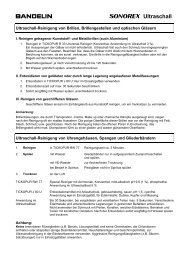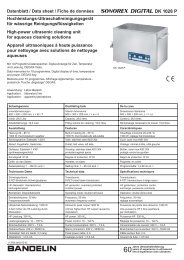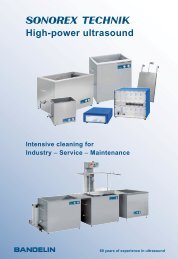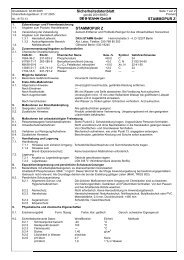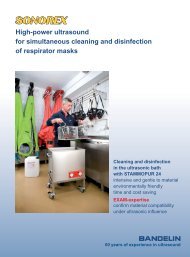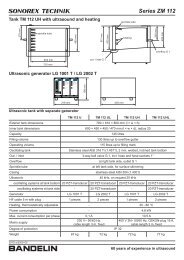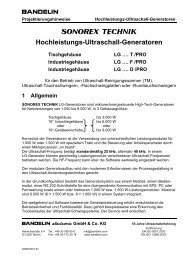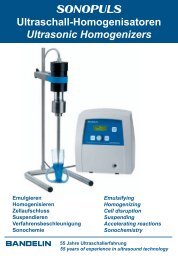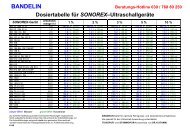Accessories - Bandelin electronic
Accessories - Bandelin electronic
Accessories - Bandelin electronic
Create successful ePaper yourself
Turn your PDF publications into a flip-book with our unique Google optimized e-Paper software.
Recommendations on ultrasonic cleaning<br />
How ultrasound works<br />
Vibrations at frequencies exceeding 18 kHz<br />
(18,000 vibrations per second) are called<br />
ultrasound. As a result of these vibrations<br />
millions of smallest vacuum bubbles are<br />
formed in liquids. They implode during the<br />
high pressure phase and create highly<br />
effective pressure waves. This process<br />
is called cavitation and causes the removal<br />
of dirt particles from the objects to be<br />
cleaned.<br />
Lower frequencies of approx. 20 kHz which<br />
are applicable in cell disruption, produce<br />
bubbles with larger diameters and stronger<br />
pressure waves than the higher frequencies<br />
of approx. 35 kHz which are used for in ten se<br />
but gentle cleaning.<br />
To achieve the ultrasonic effect in liquids,<br />
the HF generator converts the mains frequency<br />
to the corresponding frequency of the ultrasonic<br />
unit. This frequency is then transformed into<br />
mechanical vibrations by means of electromechanical<br />
transducers.<br />
Advantages of ultrasonic<br />
cleaning<br />
Ultrasonic cavitation removes dirt rapidly<br />
from items, thoroughly and deep from<br />
pores, even from diffi cult to reach places<br />
such as cavities or holes.<br />
Ultra sound cleans only in a few minutes<br />
and exceeds in its effi ciency other cleaning<br />
methods. Ultrasonic cleaning is also gentle<br />
because even slight damage like scratches<br />
are eliminated.<br />
Advantages in process engineering<br />
and sonochemistry<br />
Cavitation not only can be used for various<br />
purposes, but a very fi ne emulsion of oil<br />
and water can be produced by ultrasonic<br />
application. Compared to other manufacturing<br />
processes this emulsion is more stable.<br />
For sonochemical processes in an ultrasonic<br />
bath, the reaction vessel should have a thin<br />
bottom. Thus the ultrasonic energy, is radiated<br />
directly and effectively into the reaction vessel.<br />
- 2 -<br />
How to select the proper unit<br />
SONOREX ultrasonic baths work with the<br />
intense cleaning frequency of 35 kHz.<br />
The size and number of objects to be<br />
cleaned determine the size of the<br />
ultrasonic bath.<br />
When selecting the unit, dimensions of<br />
the accessories, e. g. baskets have to<br />
be considered. To avoid overloading, it is<br />
recommended to choose a slightly larger unit.<br />
This also allows additional applications at a<br />
later stage.<br />
Should an ultrasonic unit have a<br />
heater?<br />
Warm cleaning solutions reduce the cleaning<br />
time; dirt is removed faster. Units with heaters<br />
are the preferred choice for cleaning processes<br />
in laboratories.<br />
Disinfectant solutions must not be warmed<br />
because protein coagulation starts at a<br />
temperature of 40 °C (104° F) and this poses an<br />
obstacle for some cleaning and all disinfection<br />
processes. Therefore, units without heaters are<br />
recommended for these applications.<br />
What kind of accessories should<br />
be used?<br />
Objects to be cleaned and reaction vessels<br />
must not be placed on the tank bottom.<br />
In sert baskets avoid scratching either the parts<br />
to be cleaned or the tank bottom. Beakers are<br />
placed into positioning lids and are used for<br />
cleaning of small objects or when working with<br />
ag gressive solutions.<br />
Which cleaning agents are<br />
appropriate?<br />
TICKOPUR and STAMMOPUR cleaning and<br />
disinfectant agents have been especially<br />
developed for the application in SONOREX<br />
ultrasonic baths. Water without any cleaning<br />
agent does not clean.<br />
Household detergents or DI-water should<br />
never be used. It is necessary to use plastic<br />
insert tubs, when working with acids or<br />
removing acid residues. Flammable liquids<br />
must not be used directly in the ultrasonic<br />
tank.



